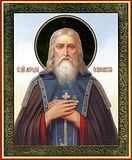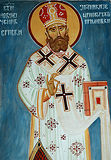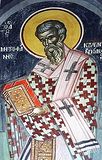

| Previous day | Next day |
| Old Style
June 4
|
Friday |
New Style
June 17
|
| First Week after Pentecost (Fast-free period). Tone 7. | No fast.
|
![]() St. Metrophanes, first archbishop of Constantinople (ca. 326).
St. Metrophanes, first archbishop of Constantinople (ca. 326). ![]() St. Methodius, founder of Peshnosha Monastery (Moscow), disciple of St. Sergius of Radonezh (1392).
St. Methodius, founder of Peshnosha Monastery (Moscow), disciple of St. Sergius of Radonezh (1392).
Martyrs Frontasius, Severinus, Severian, and Silanus, of Gaul (1st c.). Martyr Concordius of Spoleto, Italy (ca. 175). Hieromartyr Astius, bishop of Dyrrachium in Macedonia (110). St. Zosimas of Cilicia, bishop of Babylon in Egypt (6th c.). New Hieromartyr Ioannicius, metropolitan of Montenegro and the Littoral (1945). Sts. Eleazar and Nazarius, wonderworkers, of Olonets (15th c.).
Viliya Icon of the Most Holy Theotokos.
Sts. Mary and Martha, sisters of St. Lazarus (1st c.). St. Titus, bishop of Byzantium (3rd c.). Hieromartyr Apotacius and Martyrs Zoticus, Atallus, Camasius, Philip, and 31 others, including Eutychius, Quirinus, Julia, Saturninus, Ninita, Fortunio, Gaddanus, and Amasus, beheaded at Noviodunum (Niculitel) (320). St. Optatus, bishop of Milevum in Numidia (376). St. Alonius of Scetis in Egypt (5th c.). St. Petroc, abbot, in Cornwall (594). Monk-martyr John, abbot, of Monagria Monastery, near Cyzicus (761). St. Sophia of Thrace (10th c.-11th c.).
Repose of Hieromonk Bartholomew of Neamts and Svir (1864) and the sisters Vera (June 4) and Lyubov (June 8) of the Shamordino Convent (1883).
Thoughts for Each Day of the Year
According to the Daily Church Readings from the Word of God
By St. Theophan the Recluse

Friday. [Rom. 2:14–29; Matt. 5:33–41]
But I say unto you, That ye resist not evil (Matt. 5:39); in other words, allow yourself to be a victim of human selfishness and malice. But how can one live like that? Do not worry. He who gave this commandment is our Provider and Guardian. When you desire to live like this with complete faith from your whole soul, to not resist any evil, the Lord Himself will arrange a life for you which is not only bearable, but joyful. Furthermore, resistance in fact can irritate an aggressor even more and motivate him to invent new troubles, whereas a yielding demeanour disarms him and humbles him. Thus, if you would just suffer the first onslaught of malice, people will take pity on you and leave you alone, while resistance and revenge kindle malice, which is passed on from the individual to his family, and then from generation to generation.
Articles
 Martyrs Frontasius, Severinus, Severian, and Silanus, of GaulThe Holy Martyrs Frontasius, Severinus, Severianus, and Silanus suffered for Christ under the emperor Claudius (41-54). |
 Martyr Concordius of SpoletoThe Holy Martyr Concordius, son of the presbyter Gordian, was raised in piety and faith in Christ, and therefore Bishop Pius of Rome made him a subdeacon. |
 Sts. Mary and Martha, sisters of St. LazarusThe righteous sisters Martha and Mary were believers in Christ even before He raised their brother Saint Lazarus (October 17) from the dead. |
 Venerable Sophia of AinosOur venerable Mother Sophia was born in the province of Ainos in southeastern Thrace , and was the daughter of pious Christian parents. |









